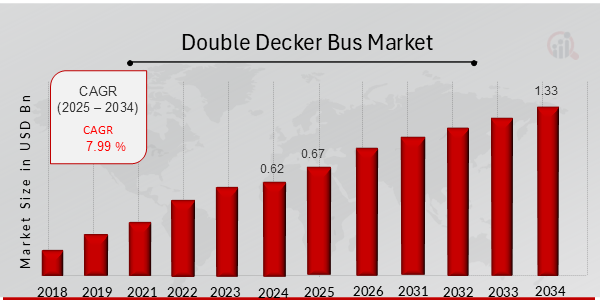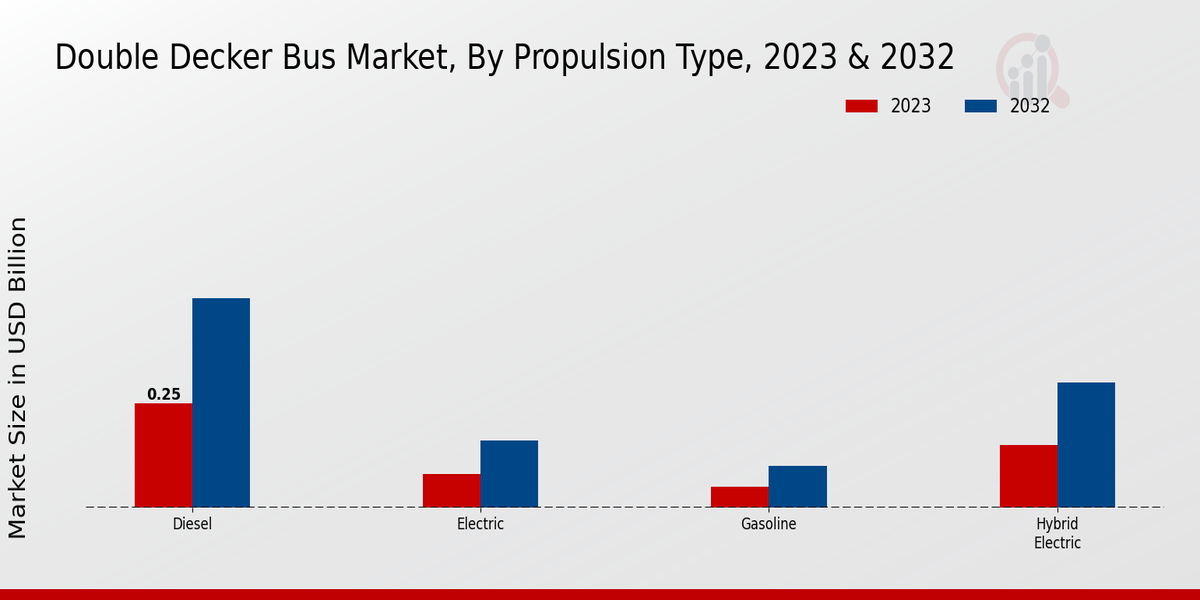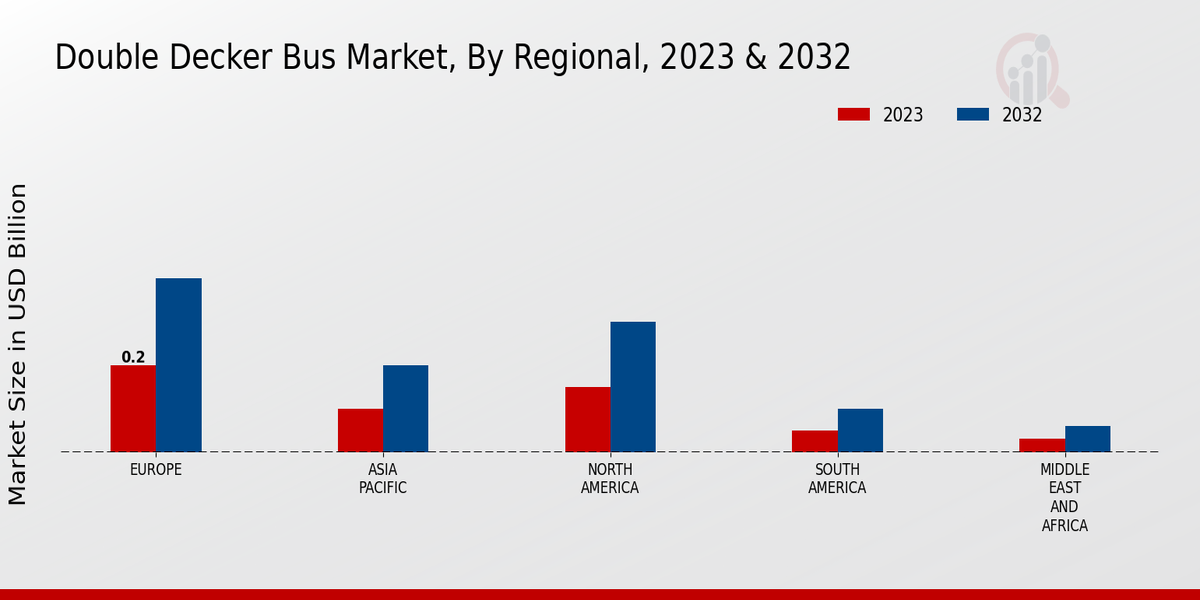Double Decker Buse Market Overview
As per MRFR analysis, the Double Decker Bus Market Size was estimated at 0.62 (USD Billion) in 2024. The Double Decker Bus Market Industry is expected to grow from 0.67 (USD Billion) in 2025 to 1.33 (USD Billion) till 2034, at a CAGR (growth rate) is expected to be around 7.99% during the forecast period (2025 - 2034).
Key Double Decker Buse Market Trends Highlighted
The double-decker bus market showcases a steady growth trajectory, driven by factors such as increasing urbanization, congestion in major cities, and the need for efficient public transportation systems. One of the key market trends is the growing adoption of electric double-decker buses, which offer environmental benefits and reduced operating costs. Additionally, technological advancements in areas like autonomous driving and advanced safety features are expected to shape the market in the coming years. Opportunities for market players lie in expanding into emerging markets and exploring innovative solutions to address transportation challenges. To capture these opportunities, companies must focus on developing sustainable, efficient, and cost-effective double-decker bus solutions.

Source Primary Research, Secondary Research, MRFR Database and Analyst Review
Double Decker Buse Market Drivers
Increasing Urbanization and Population Growth
The rapid growth of cities and the increasing population density in urban areas are driving the demand for double-decker buses. These vehicles can accommodate more passengers than traditional buses, making them an efficient and cost-effective solution for transporting large numbers of people in congested urban environments. As more and more people move to cities, the need for efficient and reliable public transportation systems will continue to grow, providing a major boost to the Global Double Decker Buse Market Industry.
Double-decker buses offer several advantages over traditional buses, including increased passenger capacity, improved fuel efficiency and reduced emissions. These factors are making them increasingly attractive to public transportation operators around the world. In addition, the growing popularity of tourism is also contributing to the demand for double-decker buses, as they provide a unique and memorable experience for tourists.
Government Regulations and Initiatives
Government regulations and initiatives are also playing a significant role in driving the growth of the Global Double Decker Buse Market Industry. Many governments are implementing policies to reduce traffic congestion and emissions in urban areas. These policies are encouraging the adoption of public transportation, which is, in turn, increasing the demand for double-decker buses. In addition, governments are also providing financial incentives to public transportation operators to purchase double-decker buses.
These incentives include grants, subsidies and tax breaks. As a result of these government initiatives, the adoption of double-decker buses is expected to accelerate in the coming years.
Technological Advancements
Technological advancements are also contributing to the growth of the Global Double Decker Buse Market Industry. The development of new materials and technologies is making double-decker buses lighter, more efficient and more durable. In addition, the integration of advanced safety features and infotainment systems is making double-decker buses more appealing to passengers. For example, some double-decker buses are now equipped with lightweight composite materials, which reduce the weight of the vehicle and improve fuel efficiency.
Other buses are equipped with hybrid or electric powertrains, which further reduce emissions and operating costs.
Double Decker Bus Market Segment Insights
Double Decker Bus Market Propulsion Type Insights
In the Double Decker Bus Market, the Propulsion Type segment plays a crucial role in driving the overall market growth and dynamics. As of 2023, the market is valued at 0.53 USD Billion, with expectations for significant growth by 2032. Within this segment, Diesel propulsion represents a substantial portion of market valuation, holding a value of 0.25 USD Billion in 2023, and is projected to increase to 0.5 USD Billion by 2032. Diesel remains a dominant choice primarily due to its availability, established infrastructure, and efficiency in long-distance transport, contributing to its majority holding in the market.
The Gasoline propulsion segment, while relatively smaller, is valued at 0.05 USD Billion in 2023, with an increase to 0.1 USD Billion by 2032. Its presence in the market is less significant but still relevant, particularly in regions where gasoline is more accessible and affordable, though it faces competition from alternative fuels. The Hybrid Electric propulsion type is gaining traction, with a 2023 market value of 0.15 USD Billion expected to grow to 0.3 USD Billion by 2032, indicating a shift towards more environmentally friendly options. Hybrid electric buses combine traditional fuels and electric power, appealing to urban transit systems focused on reducing emissions while still being cost-effective.
Lastly, the Electric segment is valued at 0.08 USD Billion in 2023 and is projected to reach 0.16 USD Billion by 2032. Although currently the smallest in the market, the Electric propulsion type is gaining popularity due to growing environmental concerns and government policies promoting electric vehicles. The overall trend in the Double Decker Bus Market is towards greener alternatives, with Hybrid Electric and Electric options increasingly being prioritized as cities aim to promote sustainability and reduce their carbon footprints. The growth of these alternatives presents significant opportunities for manufacturers and operators looking to modernize their fleets in alignment with environmental goals.

Source Primary Research, Secondary Research, MRFR Database and Analyst Review
Double Decker Bus Market Application Insights
In the Double Decker Bus Market, the Application segment plays a crucial role, with various uses that cater to different consumer needs. Public Transportation comprises a significant portion of the market, serving populations in densely populated cities where space optimization is essential. Additionally, the Tourism sector benefits from double-decker buses as they enhance sightseeing experiences, allowing travelers to enjoy expansive views while navigating urban landmarks.
Furthermore, Private Luxury Transportation leverages this market segment, appealing to affluent consumers seeking premium travel experiences. Factors driving market growth include increased urbanization and the rising preference for efficient public transport solutions. However, challenges such as regulatory frameworks and the high initial investment costs may affect market penetration. Despite these obstacles, opportunities present themselves through innovative technologies that enhance bus safety and comfort, ultimately contributing to robust Double Decker Bus Market Statistics and revenue growth across varied applications.
Double Decker Bus Market Passenger Capacity Insights
The Double Decker Bus Market is significantly influenced by the Passenger Capacity segment, which plays a crucial role in shaping market dynamics and service offerings. The focus on passenger capacity aims to optimize space while enhancing commuting experiences in urban areas. Within this segment, the categories of 50-70 Passengers, 70-90 Passengers, and 90-110 Passengers are of particular importance, demonstrating varying levels of market penetration and preference among consumers.
The 70-90 Passenger capacity category dominates as urbanization trends lead to increased ridership, necessitating larger capacity buses for effective crowd management. The majority of operators favor this range due to its balance of capacity and maneuverability, adapting well to densely populated regions. Meanwhile, the 50-70 Passengers segment serves niche markets, appealing to smaller towns or specific transit routes, while the 90-110 Passenger capacity serves high-demand routes with significant passenger volumes. The Double Decker Bus Market revenue is anticipated to be bolstered by these insights, highlighting potential growth opportunities amid ongoing urbanization and the push for sustainable transport solutions.
Double Decker Bus Market Floor Configuration Insights
The Double Decker Bus Market is witnessing notable growth driven by increasing urbanization, improved public transport infrastructure and rising demand for efficient transportation solutions. As of 2023, the market is valued at approximately 0.53 USD Billion and is projected to grow significantly. Within the floor configuration segment, the two main configurations are single-floor and double-floor buses. The double-floor configuration finds substantial favor due to its ability to accommodate a higher passenger capacity, making it a preferred choice in densely populated urban areas and city tourism, where maximizing space is critical.
Conversely, Single-floor buses, while having a lower capacity, are valued for their straightforward design and ease of access, particularly in locations where height restrictions may apply. The Double Decker Bus Market revenue reflects a broader trend towards more sustainable and efficient public transportation options, showcasing the adaptability of both floor configurations in meeting user needs, safety regulations, and operational efficiency. As cities continue to evolve, the demand for diverse bus configurations to cater to varied passenger requirements will likely drive further innovation within the Double Decker Bus Market industry.
Double Decker Bus Market Roof Type Insights
The Double Decker Bus Market revenue is significantly influenced by the Roof Type category, which primarily includes Open Top and Closed Top models. Open-top buses are particularly popular for sightseeing tours in cities, offering passengers an unobstructed view of the surroundings, thereby enhancing the travel experience. Meanwhile, Closed-top buses cater to regular commuter services, providing shelter from adverse weather conditions, and are favored for their operational efficiency.
The segregation in this market highlights the diverse preferences and requirements of different consumer segments, contributing to the overall growth trajectory of the Double Decker Bus Market. As this market continues to evolve, growth drivers include advancements in bus design and increasing investments in public transport infrastructure. However, challenges like regulatory compliance and maintenance costs remain pertinent. Overall, the Double Decker Bus Market data indicate a promising future, with a strong inclination towards expanding these Roof Type categories to meet the varying demands of urban mobility.
Double Decker Bus Market Regional Insights
The Double Decker Bus Market has witnessed notable growth in various regions, reflecting its diverse applications and demand trends. In 2023, North America led with a market valuation of 0.15 USD Billion, expected to increase to 0.3 USD Billion by 2032, showcasing its significant role in urban transport solutions. Europe followed closely, valued at 0.2 USD Billion in 2023, with projections of reaching 0.4 USD Billion by 2032, highlighting its dominance in public transportation innovations. South America, while smaller at 0.05 USD Billion in 2023, is poised to double to 0.1 USD Billion by 2032, indicating a growing adoption of double-decker buses in cities aiming to enhance passenger capacity.
The Asia Pacific region, currently valued at 0.1 USD Billion, is expected to reach 0.2 USD Billion, driven by urbanization and increased public transport investments. In the Middle East and Africa, the market appeared limited at 0.03 USD Billion in 2023 but could rise to 0.06 USD Billion by 2032, indicating emerging potential in developing urban areas. Overall, the Double Decker Bus Market statistics reflect varying growth rates and trends across these regions, emphasizing the significance of regional preferences and urban transport policies in shaping the market landscape.

Source Primary Research, Secondary Research, MRFR Database and Analyst Review
Double Decker Buse Market Key Players And Competitive Insights
Major players in Double Decker Buse Market industry are continuously striving to develop innovative products to meet the evolving needs of consumers. Leading Double Decker Buse Market players are investing heavily in research and development to enhance the performance and efficiency of their buses. The Double Decker Buse Market is witnessing a growing trend towards the adoption of electric and hybrid buses, which are more environmentally friendly and cost-effective in the long run. This shift towards sustainable transportation solutions is being driven by government regulations and incentives, as well as increasing consumer awareness about the environmental impact of fossil-fuel-powered vehicles.
Alexander Dennis Limited, a leading player in the Global Double Decker Buse Market, is focused on providing innovative and sustainable transportation solutions to its customers. The company offers a wide range of double-decker buses, including the Enviro400 and the Enviro500, which are renowned for their fuel efficiency, reliability, and passenger comfort. Alexander Dennis Limited is committed to reducing its environmental footprint and has set ambitious targets for reducing its carbon emissions. The company is also actively involved in developing and testing new technologies, such as electric and hydrogen-powered buses.
Another key player in the Global Double Decker Buse Market is Volvo Buses, which is known for its high-quality and technologically advanced buses. The company offers a range of double-decker buses, including the Volvo B9TL and the Volvo B5LHC, which are designed to meet the specific needs of different markets and applications. Volvo Buses is committed to providing safe, reliable, and comfortable transportation solutions to its customers. The company is also investing heavily in research and development to develop new technologies that will further improve the efficiency and sustainability of its buses.
Key Companies in the Double Decker Buse Market Include
- Alexander Dennis Limited
- Iveco Group N.V.
- Daimler Truck AG
- Airbus SE
- MAN Truck Bus AG
- Tata Motors Limited
- King Long United Automotive Industry Co., Ltd.
- Foton Motor Company Limited
- Scania AB
- Volvo Buses
- Marcopolo S.A.
- Higer Bus Company Limited
- Beijing Public Transport Corporation (BPTC)
- Eicher Motors Limited
- Henan Shaolin Bus
Double Decker Buse Market Industry Developments
The double-decker bus market was valued at USD 0.67 billion in 2025 and is projected to reach USD 1.33 billion by 2034, exhibiting a CAGR of 7.99% during the forecast period. The growth of the market is attributed to the increasing demand for public transportation, rising urbanization, and the growing popularity of double-decker buses for sightseeing and tourism purposes.
Recent developments in the market include the launch of new models with advanced features, such as electric and hybrid double-decker buses, by leading manufacturers like Alexander Dennis and Volvo. These new models are gaining traction due to their environmental benefits and improved passenger comfort. Additionally, government initiatives to promote sustainable transportation are expected to further drive market growth over the coming years.
Double Decker Bus Market Segmentation Insights
- Double Decker Bus Market Propulsion Type Outlook
- Diesel
- Gasoline
- Hybrid Electric
- Electric
- Double Decker Bus Market Application Outlook
- Public Transportation
- Tourism
- Private Luxury Transportation
- Double Decker Bus Market Passenger Capacity Outlook
- 50-70 Passengers
- 70-90 Passengers
- 90-110 Passengers
- Double Decker Bus Market Floor Configuration Outlook
- Single Floor
- Double Floor
- Double Decker Bus Market Roof Type Outlook
- Open Top
- Closed Top
- Double Decker Bus Market Regional Outlook
- North America
- Europe
- South America
- Asia Pacific
- Middle East and Africa
|
Report Attribute/Metric
|
Details
|
|
Market Size 2024
|
0.62 (USD Billion)
|
|
Market Size 2025
|
0.67 (USD Billion)
|
|
Market Size 2034
|
1.33 (USD Billion)
|
|
Compound Annual Growth Rate (CAGR)
|
7.99% (2025 - 2034)
|
|
Report Coverage
|
Revenue Forecast, Competitive Landscape, Growth Factors, and Trends
|
|
Base Year
|
2024
|
|
Market Forecast Period
|
2025 - 2034
|
|
Historical Data
|
2019 - 2023
|
|
Market Forecast Units
|
USD Billion
|
|
Key Companies Profiled
|
Alexander Dennis Limited, Iveco Group N.V., Daimler Truck AG, Airbus SE, MAN Truck Bus AG, Tata Motors Limited, King Long United Automotive Industry Co., Ltd., Foton Motor Company Limited, Scania AB, Volvo Buses, Marcopolo S.A., Higer Bus Company Limited, Beijing Public Transport Corporation (BPTC), Eicher Motors Limited, Henan Shaolin Bus
|
|
Segments Covered
|
Propulsion Type, Application, Passenger Capacity, Floor Configuration, Roof Type, Regional
|
|
Key Market Opportunities
|
1. Emerging markets growth
2. Technological advancements
3. Sustainability initiatives
4. Increased tourism
|
|
Key Market Dynamics
|
1. Growing urbanization
2. Increasing tourism
3. Government initiatives
4. Technological advancements
5. Environmental concerns
|
|
Countries Covered
|
North America, Europe, APAC, South America, MEA
|
Frequently Asked Questions (FAQ) :
The Double Decker Bus Market is expected to be valued at 1.33 USD Billion in 2034.
The market is expected to grow at a CAGR of 7.99% from 2025 to 2034.
By 2032, Europe is expected to hold a significant market share valued at approximately 0.4 USD Billion.
The North American market for double-decker buses is projected to be worth around 0.3 USD Billion in 2032.
The Diesel propulsion type is expected to be valued at 0.5 USD Billion by 2032.
Key players in the market include Alexander Dennis Limited, Daimler Truck AG, and Tata Motors Limited, among others.
The Electric propulsion type is expected to reach a market size of 0.16 USD Billion by 2032.
The South American double-decker bus market is expected to grow to approximately 0.1 USD Billion by 2032.
The market for Hybrid Electric propulsion type is projected to be worth around 0.3 USD Billion in 2032.
The market may face challenges such as competition from alternative transport solutions and regulatory changes.

















